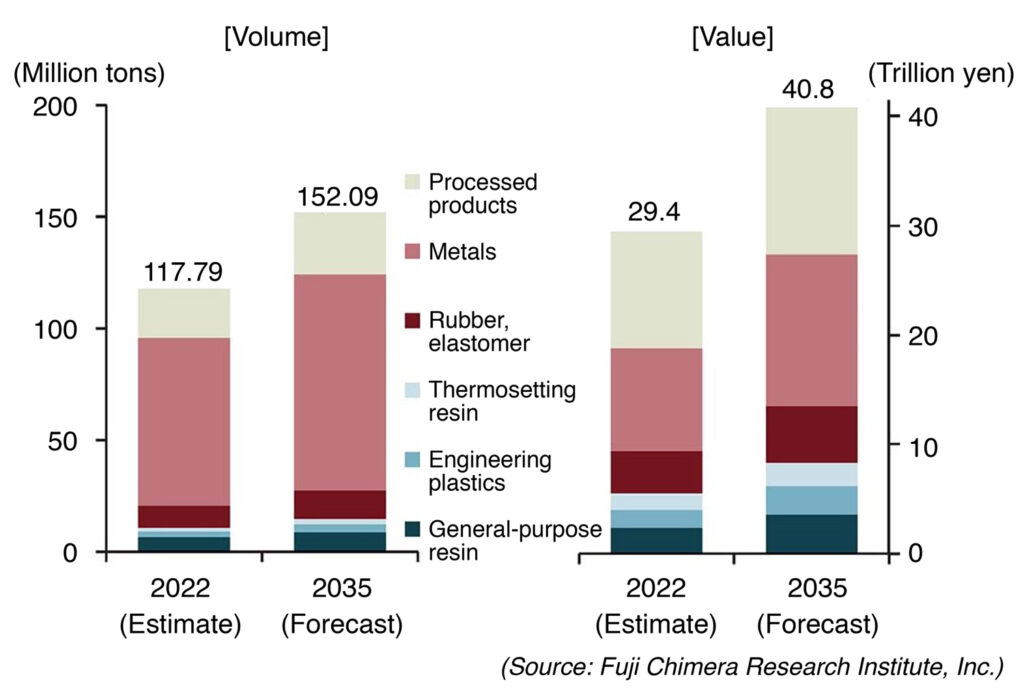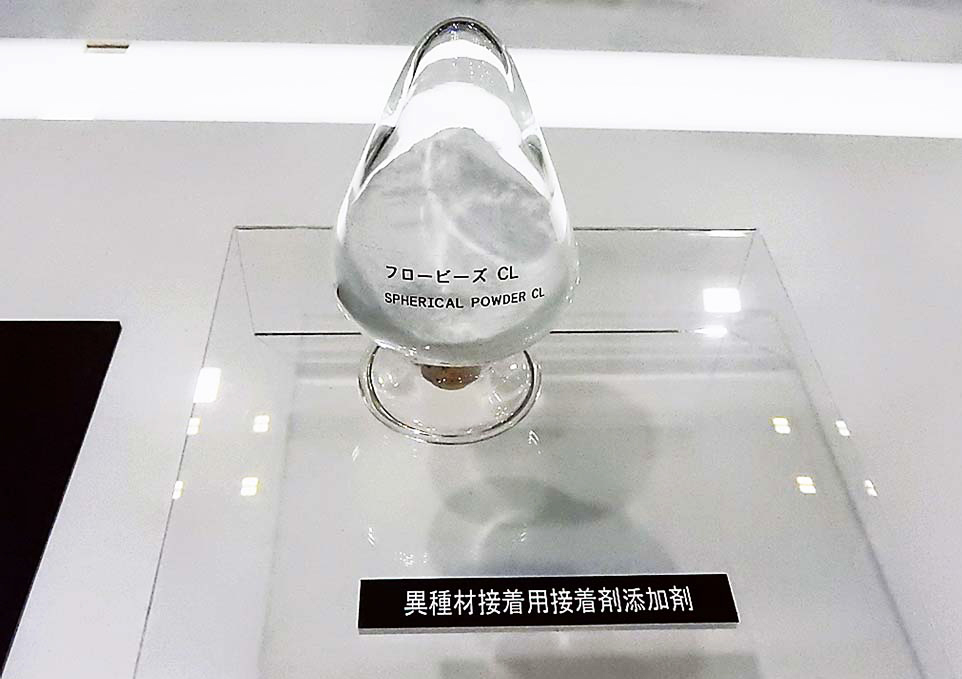ASIA ELECTRONICS INDUSTRYYOUR WINDOW TO SMART MANUFACTURING
Electronic Materials Ride on Waves of Mobility, Advanced ICT
Recently, innovations in electronic materials are gathering momentum. Information, electronic, and mobility technologies are driving the development of new electronic materials. Moreover, industry calls for decarbonization or carbon neutrality propel the demand for innovative electronic materials.

Industry Performance, Forecast
In the first half of 2020, the electronic materials market slowed down with the global weakening of economic activities amid the COVID-19 pandemic. However, the demand recovered in the second half of 2020 reflecting the increase in demand for electronic devices prompted by work-at-home and stay-at-home policies. The recovery of the U.S. and Chinese automotive markets in summer and onward also helped increase the demand for electronic materials.
Moreover, steady demand continued in the beginning of 2021. In Feb. 2021, a cold wave struck the State of Texas in the United States, forcing local chemical plants to halt operations for a long period of time. This triggered materials shortages around the world. Prices of some resin materials and metal materials soared, while sourcing has also become a challenge. Such situation continued in the second half of 2021 and onward. Furthermore, in the second half of 2021, tight logistics worldwide disrupted supply chain. For these reasons, electronic materials manufacturers took various measures, including reviewing their procurement routes to secure materials.
In the first half of 2022, the electronic materials market grew steadily as a whole on the back of the expansion of the demand for electronic components and semiconductors. Materials shortages and tight logistics gradually eased. However, Russia’s invasion of Ukraine caused resource and energy prices to rise. Furthermore, rapid depreciation of the yen in spring and onward caused imported materials prices to rise. These factors squeezed manufacturers’ earnings.
In the second half of 2022, the demand for IT equipment stagnated, and the demand for electronic components decreased. In addition, some manufacturers postponed investments in semiconductor equipment. Thus, the market landscape of electronic materials also became somewhat unsteady.
The electronic materials market in the first half of 2023 is forecast to be weak. Nonetheless, it is expected to recover gradually toward the second half of the year. Factors like the recovery of the global auto production; increase in demand for xEVs; expansion of 5G; and increase in sustainability-related investments will propel this trend. Demand for materials used in mobile terminals and data centers will also turn around after adjustments have settled. In addition, new devices related to digital transformation (DX), green transformation (GX), IoT, and metaverse, will create new demand for electronic materials.
In the electronic materials industry, mergers and acquisitions (M&A), alliances between companies, and partnerships with start-up companies around the world are also gaining traction. Also, many companies pursue open innovation. They are accelerating efforts in various fields, including ICT, mobility, environment and energy, and life science.
In terms of enhancing production process, importance is placed on productivity improvement through digital innovation using AI. Manufacturers also implement materials informatics to speed up research and development.
Japanese Materials Makers: Trends, Strengths
Specifically, Japanese materials manufacturers are stepping up technological development setting their sights on future trends. Additionally, they develop advanced materials, making the most of their respective core technologies. Manufacturers prioritize connected, autonomous, shared and services, and electric (CASE) trend; fifth-generation (5G)/beyond 5G communications; next-generation semiconductor processes; and sustainability in their development agenda. Moreover, they strengthen capital investment strategies by looking into medium and long-term goals.
Electronic materials play important roles as core materials that support the technological advancement of various electric and electronic equipment. Additionally, they also support semiconductor and electronic components; displays; automobiles; factory automation (FA) equipment/manufacturing equipment; and medical/healthcare-related equipment. Electronic materials also support communication and social infrastructure.
Japan’s electronic materials industry contributes to innovations of equipment and systems. It leverages on its strengths, including high technology development capability, high quality and reliability, and advanced process technology. They also propose suitable solutions to customers. Thus, Japanese electronic materials companies are highly regarded around the world. Specifically, they maintain the top share in the global semiconductor materials field. Furthermore, they also secure more than 50 percent global share for materials of advanced devices in several other product fields.

Materials for electronics and mobility sectors
Recently, in the electronics and mobility markets, new trends are also becoming dominant. These include the advancement of automotive technology with CASE trend at core; progress in large-capacity, high-speed communications; advancement of semiconductor process technology; wider adoption of internet of things (IoT) and artificial intelligence (AI); big data; decarbonization and carbon neutrality. Also, these trends created the needs for new materials supporting new technologies. Moreover, electronic components manufacturers aim for continuous growth eyeing the technology advancement. Specifically, they step up technological development, marketing strategies, and investment strategies with medium and long-term perspective.
Materials for power electronics and battery materials for electrified vehicles (xEVs) are being actively developed in the automotive-related field. In 2022, the unit production of automobiles increased only slightly from 2021 as affected by prolonged semiconductor shortage. On the other hand, the global production of xEVs significantly increased from the previous year. High growth of the xEV market is expected to continue in 2023 and onward. Makers of electronic materials will create a major difference by brushing up their products for xEVs. Specifically, they focus efforts on the development of materials that contribute to lighter xEV bodies.
In the area of high-functional mobile terminals, manufacturers put strengths into the development of new materials that feature excellent high-frequency characteristics and support high-speed, large-capacity 5G communications. Also, they funnel their energy into the development of high-performance materials that support high-density mounting of terminals and next-generation display materials.
Materials for semiconductors
In the semiconductor-related field, next-generation semiconductor process materials are actively developed and marketed. In the semiconductor lithography field, process materials for advanced lithography technologies, such as argon fluoride (ArF) and extreme ultraviolet (EUV) lithography are emerging. Moreover, expansion of the supply system is under way.
Higher processing speeds, larger data capacities and higher integration of semiconductors will lead to further miniaturization of circuit patterns on semiconductor chips. Manufacturers of semiconductor process materials aim to obtain industry standards by quickly developing materials that satisfy next-generation needs. Recently, the demand for conventional process materials, such as photoresists for i-line lithography, is expanding again. This trend reflects the expansion of the base of the semiconductor market.
Meanwhile, for next-generation power semiconductors for automobiles and industrial equipment, the development of silicon carbide (SiC) and gallium nitride (GaN) materials becomes active. Moves to boost their capabilities are also gaining steam. Furthermore, new technologies related to gallium oxide (Ga2O3) development also progress. Ga2O3 is regarded as a wide bandgap material with superior cost efficiency than SiC and GaN.
New materials that support next-generation displays, energy-saving lightings, and lighter drones are also emerging.
Materials for energy field
In the environment and energy-related field, new materials that cause innovations in lithium-ion rechargeable batteries (LIB), all-solid-state batteries, next-generation solar cells, fuel cells, and energy storage systems, are also emerging.




